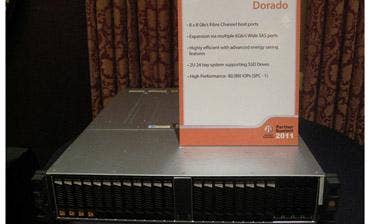Huawei Symantec Intros SSD Array, Shows Hi-End Storage Roadmap

Huawei Symantec Technologies on Monday unveiled the company's first SSD storage appliance which the company said can be optimized in the field to meet customers' varying needs for SSD-based storage or high-performance cache.
The company also unveiled significant enhancements planned for its flagship unified storage platform, and introduced its first significant customer win in North America.
The news was unveiled during Huawei Symantec's first-ever North America Partner Summit, held this week in Cupertino, Calif.
Huawei Symantec is a joint venture between Huawei Technologies, one of China's largest electronics companies, and Symantec, the world's largest independent provider of security and storage software. The company is rapidly building an indirect sales channel to help it take on the industry's most established server and storage vendors.
It was founded in 2008 as a developer of network security appliances combining the hardware capabilities of Huawei and the security software capabilities of Symantec, and has since expanded its product lines to storage and servers..
The Huawei Symantec Dorado 2100 Storage Series of SSD appliances can be configured with up to 24 SSDs in a 2U rack mount chassis. The unit features eight 8-Gbps Fibre Channel host ports, and can be expanded with 6-Gbps SAS ports.
Performance of the Dorado S2100 is 80,000 I/Os per second (IOPs), said Ken Zarrabi, senior product management manager for Huawei Symantec.
Pricing is under 32 cents per IOP, Zarrabi said. "As far as I know, you can't beat our price per IOP," he said.
The Dorado S2100, which Zarrabi said was designed from the ground-up by Huawei Symantec, lets solution providers and customers tweak the performance to optimize it for use either as a storage array or as an extension of a server's cache.
That makes it suitable for a wide variety of uses for getting around I/O performance bottlenecks, including using it as an index for data bases, for dynamic tiring of existing storage, and as primary storage in high performance computing environments, Zarrabi said. "It's very important to be able to change the storage as needed," he said.
Huawei Symantec also unveiled its roadmap for its N8000-series of scale-out, unified SAN and NAS storage arrays.
This quarter, the company plans to make the N8000 arrays more virtualization-friendly with the addition of VMware's vCenter plugins, which provides the ability to manage and provision storage through VMware's vCenter virtualization and cloud management application. Zarrabi said Huawei Symantec also plans to add the ability to clone hundreds of VMware VMDK (Virtual Machine Disk Format) files.
Also slated for the N8000 arrays this quarter are new disaster recovery features including new block-level deduplication, failover, and RPO (recovery point objective) reporting capabilities, Zarrabi said.
Early next year, Huawei Symantec plans to add the representational state transfer (REST) interface, which provides the ability to build a single storage interface that shows customers their local and cloud storage.
The company also plans to add iSCSI and Symantec NetBackup media server capabilities; stretch cluster, which allows nodes in a cluster to be geographically dispersed; SEC-certified WORM (write once, read many) capability; integration with the KVM and Citrix virtual desktop infrastructure; and the ability to throttle replication bandwidth, Zarrabi said.
Huawei Symantec is also looking to provide customer win examples to its solution providers, and at its partner conference introduced its high-performance storage cluster win at the University of Tennessee's National Center for Computational Engineering.
High-performance Storage For U-Tenn
MPAK Technology, a San Diego-based solution provider and Huawei Symantec partner, just finished a project to install a Huawei N8300 array with two controllers and 29 JBOD (just a bunch of disk, or non-RAID) expansion units for a total of 1.3 PBs of capacity.
Mike Kornblum, president and chief storage architect of MPAK, said he closed the deal in the face of competition from EMC, NetApp, BlueArc, and several other vendors.
Wally Edmondson, data center manager for the Center, said over the phone during the partner conference that his organization does a lot of computational fluid testing. "We needed 4 GBs per second throughput, and as much as we could buy of it," Edmondson said.
The system was installed a month and a half ago, and is doing what was promised, Edmondson said. Just last week, the system was performing at 5 GBs per second, and Edmondson said he expects it to reach up to 6 GBs per second once the installation is complete.